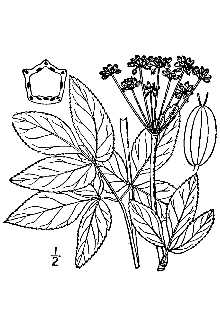Golden Zizia
Scientific Name: Zizia aurea (L.) W.D.J. Koch

| General Information | |
|---|---|
| Usda Symbol | ZIAU |
| Group | Dicot |
| Life Cycle | Perennial |
| Growth Habits | Forb/herb |
| Native Locations | ZIAU |
Plant Guide
Use a soil moisture meter to monitor the soil moisture where Golden Zizia is planted.
Fact Sheet
Alternate Name
Golden zizia , Use soil moisture sensors to measure the soil moisture of Golden Zizia.
Uses
Golden Alexanders has its greatest potential as a component of conservation mixes and wildflower gardens. In wet, sunny meadows and open woodlands it will naturalize. The flowers are attractive to many kinds of butterflies and many other insects. It is an excellent source of accessible pollen and nectar to many beneficial insects with short mouthparts.
Status
Please consult the PLANTS Web site and your State Department of Natural Resources for this plant’s current status (e.g. threatened or endangered species, state noxious status, and wetland indicator values).
Description and Adaptation
Adaptation
Adaptation
Golden Alexanders is a member of the carrot family, Apiaceae. It is an upright, native, perennial forb growing to .4 – .75 meters (1 – 2 feet) in height. The leaves are up to 8 centimeters long and 5 centimeters across, have finely serrated margins, generally lanceolate or ovate in shape and the larger leaves usually have 1 or 2 sharp lobes. Lower (basal) leaves are twice or three times compound with long petioles, while the upper leaves are once compound with short petioles. Golden Alexanders is most noteworthy for its attractive bright yellow flower which occurs from May – June. The flower is less than .3 centimeters long. Each flower has 5 sepals, 5 petals and 5 stamens. A cluster of flowers gathers into an 8 centimeter long flat-topped flower head, the middle flower of each compound umbel being stalk less. Flowers give way to 3 – 4 millimeter long, oblong, green fruit capsules. The leaves as well as the fruit slowly turn light purple in the autumn. Golden Alexanders is a carefree plant which occurs naturally in small colonies on wet soils. It prefers wet sites, but is very tolerant of dry conditions in the summer. The preference is for full to partial sun, although light shade under trees is tolerated. Distribution: This species is widely distributed from Quebec to Saskatoon, south to Florida and Texas in USDA hardiness zones 4 – 9. Habitats include: moist black soil prairies, openings in moist to mesic woodlands, savannas, thickets, limestone glades and bluffs, power line clearings in woodland areas, and abandoned fields.
Production
Propagation by Seed Large round seed capsules ripen slowly in flattened heads or umbels. They are green for much of the summer then gradually darken to burgundy and then brown, at which time they can be removed and crushed to release the dark brown seeds. Seed will germinate after 90 days moist, cold stratification at 4º C. The seed of golden Alexanders germinate at high percentages. The resulting seedlings can be transplanted into containers by midsummer; and plants will be at flowering size by the following spring.
Establishment
This species is probably best planted in the spring or early fall from containerize stock to ensure success. Unstratified seed may also be fall planted, although germination the following spring may not be as predictable.
Management
Golden Alexanders is a hardy plant with relatively few problems. This species is easy to grow and maintain with moderate levels of N, P and K. It will naturalize under optimal conditions.
Pests and Potential Problems
Golden Alexanders is a plant with relatively few pest and disease problems. Plants tend to bolt and the foliage depreciates as the summer progresses. Cultivars, Improved, and Selected Materials (and area of origin) There are no recommended cultivars or selected materials at this time. Golden Alexanders is somewhat available from commercial nurseries specializing in native plants. Prepared By and Species Coordinator: Shawn Belt NRCS, National Plant Materials Center Beltsville, Maryland
